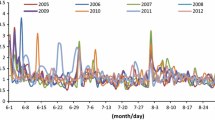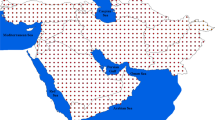Abstract
The human body can withstand high temperatures to some extent, but exposure to temperatures exceeding human heat tolerance leads to sickness and, at very high temperatures, to death. In this study, using the analyzed data on the maximum temperature at 2 m above the surface in a 73-year period from 1948 to 2020, the seasonal, annual, decadal and centennial frequency of lethal temperatures above 50 °C (TU50c) in the Northern Hemisphere (NH) was analyzed. The aim of this research was to extract the frequency and trend in TU50c in the NH. In this study, regression analysis, trend component analysis and wavelet analysis were used. Examination of the frequency of TU50c occurrence in the NH showed that the trend of annual changes in the frequency of TU50c in the NH is upward and significant. Inter-decadal changes indicate that in the fifth decade (1980–1989) and sixth decade (1990–1999), there was an unprecedented increase in the frequency of TU50c. Inter-century changes also show that the incidence of TU50c has increased gradually from the twentieth to the twenty-first century. The highest incidence of twentieth-century TU50c extreme temperatures occurred between 1986 and 1988. Spatially, the region with the highest frequency and strongest TU50c is in Africa, especially Sudan, West Asia (between Iraq, southwestern Iran, Kuwait and Saudi Arabia) and India in the Indian subcontinent. These temperatures are not uncommon in the United States, but TU50c has not been reported in Europe and East Asia. The results of statistical analysis show that the frequency of occurrence of TU50c in the NH is related to the annual frequency of sunspots and also, to a much lesser extent, to the concentration of carbon dioxide.















Similar content being viewed by others
References
Alahmad, B., Shakarchi, A. F., Khraishah, H., Alseaidan, M., Gasana, J., Al-Hemoud, A., Koutrakis, P., & Fox, M. A. (2020). Extreme temperatures and mortality in Kuwait: Who is vulnerable? Science of the Total Environment, 732, 139289. https://doi.org/10.1016/J.SCITOTENV.2020.139289
Anderson, B. G., & Bell, M. L. (2009). Weather-related mortality: How heat, cold, and heat waves affect mortality in the United States. Epidemiology (Cambridge, Mass.), 20(2), 205. https://doi.org/10.1097/EDE.0B013E318190EE08
Asseng, S., Spänkuch, D., Hernandez-Ochoa, I. M., & Laporta, J. (2021). The upper temperature thresholds of life. The Lancet Planetary Health, 5(6), e378–e385. https://doi.org/10.1016/S2542-5196(21)00079-6
Auger, N., Fraser, W. D., Smargiassi, A., & Kosatsky, T. (2015). Ambient heat and sudden infant death: A case-crossover study spanning 30 years in Montreal, Canada. Environmental Health Perspectives, 123(7), 712–716. https://doi.org/10.1289/EHP.1307960
Ban, J., Xu, D., He, M. Z., Sun, Q., Chen, C., Wang, W., Zhu, P., & Li, T. (2017). The effect of high temperature on cause-specific mortality: A multi-county analysis in China. Environment International, 106, 19. https://doi.org/10.1016/J.ENVINT.2017.05.019
Chen, R., Yin, P., Wang, L., Liu, C., Niu, Y., Wang, W., Jiang, Y., Liu, Y., Liu, J., Qi, J., You, J., Kan, H., & Zhou, M. (2018). Association between ambient temperature and mortality risk and burden: Time series study in 272 main Chinese cities. BMJ. https://doi.org/10.1136/BMJ.K4306
Choi, G., Collins, D., Ren, G., Trewin, B., Baldi, M., Fukuda, Y., Afzaal, M., Pianmana, T., Gomboluudev, P., Huong, P. T. T., Lias, N., Kwon, W. T., Boo, K. O., Cha, Y. M., & Zhou, Y. (2009). Changes in means and extreme events of temperature and precipitation in the Asia-Pacific Network region, 1955–2007. International Journal of Climatology, 29(13), 1906–1925. https://doi.org/10.1002/JOC.1979
Christidis, N., Jones, G. S., & Stott, P. A. (2014). Dramatically increasing chance of extremely hot summers since the 2003 European heatwave. Nature Climate Change, 5(1), 46–50. https://doi.org/10.1038/nclimate2468
Chung, Y., Bell, M. L., & Kim, H. (2015). Re: Mortality related to extreme temperature for 15 cities in Northeast Asia Response. Epidemiology, 26(5), E63–E63. https://doi.org/10.1097/EDE.0000000000000333
Frumkin, H., & McMichael, A. J. (2008). Climate change and public health: Thinking, communicating, acting. American Journal of Preventive Medicine, 35(5), 403–410. https://doi.org/10.1016/J.AMEPRE.2008.08.019
Gasparrini, A., Guo, Y., & Hashizume, M. (2015). Mortality risk attributable to high and low ambient temperature: A multicountry observational study. The Lancet, 386(9991), 369–375. https://doi.org/10.1016/S0140-6736(14)62114-0
Grinsted, A., Moore, J. C., & Jevrejeva, S. (2004). Application of the cross wavelet transform and wavelet coherence to geophysical time series. Nonlinear Processes in Geophysics, 11(5/6), 561–566. https://doi.org/10.5194/NPG-11-561-2004
Gu, S., Zhang, L., Sun, S., Wang, X., Lu, B., Han, H., Yang, J., & Wang, A. (2020). Projections of temperature-related cause-specific mortality under climate change scenarios in a coastal city of China. Environment International, 143, 105889. https://doi.org/10.1016/J.ENVINT.2020.105889
Jahanbakhsh, S., Edalatdoust, M., & Tadaion, M. (2011). Urmia lake as a classic indicator of sun/climate relationship in the northwest of Iran. Geographical Research., 25, 49–76. in Persian.
Kampe, E. O. I., Kovats, S., & Hajat, S. (2016). Impact of high ambient temperature on unintentional injuries in high-income countries: A narrative systematic literature review. British Medical Journal Open, 6(2), e010399. https://doi.org/10.1136/BMJOPEN-2015-010399
Karanikolos, M., Mladovsky, P., Cylus, J., Thomson, S., Basu, S., Stuckler, D., MacKenbach, J. P., & McKee, M. (2013). Financial crisis, austerity, and health in Europe. The Lancet, 381(9874), 1323–1331. https://doi.org/10.1016/S0140-6736(13)60102-6
Kjellstrom, T. (2009). Climate change, direct heat exposure, health and well-being in low and middle-income countries. Global Health Action. https://doi.org/10.3402/GHA.V2I0.1958
Martínez-Solanas, È., Quijal-Zamorano, M., Achebak, H., Petrova, D., Robine, J. M., Herrmann, F. R., Rodó, X., & Ballester, J. (2021). Projections of temperature-attributable mortality in Europe: A time series analysis of 147 contiguous regions in 16 countries. The Lancet Planetary Health, 5(7), e446–e454. https://doi.org/10.1016/S2542-5196(21)00150-9
McGeehin, M. A., & Mirabelli, M. (2001). The potential impacts of climate variability and change on temperature-related morbidity and mortality in the United States. Environmental Health Perspectives, 109(suppl 2), 185–189. https://doi.org/10.1289/EHP.109-1240665
Medina-Ramón, M., & Schwartz, J. (2007). Temperature, temperature extremes, and mortality: A study of acclimatisation and effect modification in 50 US cities. Occupational and Environmental Medicine, 64(12), 827–833. https://doi.org/10.1136/OEM.2007.033175
Moore, J., Grinsted, A., & Jevrejeva, S. (2006). Is there evidence for sunspot forcing of climate at multi-year and decadal periods? Geophysical Research Letters, 33(17), 17705. https://doi.org/10.1029/2006GL026501
Ng, C. F. S., Ueda, K., Takeuchi, A., Nitta, H., Konishi, S., Bagrowicz, R., Watanabe, C., & Takami, A. (2014). Sociogeographic variation in the effects of heat and cold on daily mortality in Japan. Journal of Epidemiology, 24(1), JE20130051. https://doi.org/10.2188/JEA.JE20130051
Nordio, F., Zanobetti, A., Colicino, E., Kloog, I., & Schwartz, J. (2015). Changing patterns of the temperature–mortality association by time and location in the US, and implications for climate change. Environment International, 81, 80–86. https://doi.org/10.1016/J.ENVINT.2015.04.009
Pachauri, R. K., Allen, M. R., Barros, V. R., Broome, J., Cramer, W., Christ, R., Church, J. A., Clarke, L., Dahe, Q., Dasgupta, P., Dubash, N. K., Edenhofer, O., Elgizouli, I., Field, C. B., Forster, P., Friedlingstein, P., Fuglestvedt, J., Gomez-Echeverri, L., Hallegatte, S., et al. (2014). Climate change 2014: Synthesis report. Contribution of Working Groups I, II and III to the fifth assessment report of the intergovernmental panel on climate change. EPIC3Geneva, Switzerland, IPCC, 151 p., Pp. 151, ISBN: 978–92–9169–143–2. https://www.ipcc.ch/pdf/assessment-report/ar5/syr/SYR_AR5_FINAL_full_wcover.pdf
Pal, J. S., & Eltahir, E. A. B. (2015). Future temperature in southwest Asia projected to exceed a threshold for human adaptability. Nature Climate Change, 6(2), 197–200. https://doi.org/10.1038/nclimate2833
Royé, D., Codesido, R., Tobías, A., & Taracido, M. (2020). Heat wave intensity and daily mortality in four of the largest cities of Spain. Environmental Research, 182, 109027. https://doi.org/10.1016/J.ENVRES.2019.109027
Silveira, I. H., Cortes, T. R., de Oliveira, B. F. A., & Junger, W. L. (2021). Projections of excess cardiovascular mortality related to temperature under different climate change scenarios and regionalized climate model simulations in Brazilian cities. Environmental Research, 197, 110995. https://doi.org/10.1016/J.ENVRES.2021.110995
Slivinski, L. C., Compo, G. P., Whitaker, J. S., Sardeshmukh, P. D., Giese, B. S., McColl, C., Allan, R., Yin, X., Vose, R., Titchner, H., Kennedy, J., Spencer, L. J., Ashcroft, L., Brönnimann, S., Brunet, M., Camuffo, D., Cornes, R., Cram, T. A., Crouthamel, R., et al. (2019). Towards a more reliable historical reanalysis: Improvements for version 3 of the Twentieth Century Reanalysis system. Quarterly Journal of the Royal Meteorological Society, 145(724), 2876–2908. https://doi.org/10.1002/QJ.3598
Thompson, R., Hornigold, R., Page, L., & Waite, T. (2018). Associations between high ambient temperatures and heat waves with mental health outcomes: A systematic review. Public Health, 161, 171–191. https://doi.org/10.1016/J.PUHE.2018.06.008
Tong, S. L., Olsen, J., & Kinney, P. L. (2021). Climate change and temperature-related mortality: Implications for health-related climate policy. Biomedical and Environmental Sciences, 34(5), 379–386. https://doi.org/10.3967/BES2021.050
Torrence, C., & Compo, G. P. (1998). A practical guide to wavelet analysis. Bulletin of the American Meteorological Society, 79(1), 61–78. https://doi.org/10.1175/1520-0477(1998)079
Wu, X., Lu, Y., Zhou, S., Chen, L., & Xu, B. (2016). Impact of climate change on human infectious diseases: Empirical evidence and human adaptation. Environment International, 86, 14–23. https://doi.org/10.1016/J.ENVINT.2015.09.007
Zerafati, H., Ghavidel, Y., & Farajzadeh, M. (2021). Historical reconstruction and statistical survey on long-term temporal changes in temperatures above 50 °C in West Asia. Arabian Journal of Geosciences, 14(21), 2242. https://doi.org/10.1007/s12517-021-08611-0
Funding
The author(s) received no financial support for the research, authorship, and/or publication of this article.
Author information
Authors and Affiliations
Contributions
The authors’ participation in the article is as follows: Conceived and designed the analysis: YG, MK. Collected the data: MK, YG. Contributed data or analysis tools: MF, MK, YG. Performed the analysis: MK, YG. Wrote the paper: MK. Supervision: YG. Corresponding author: YG.
Corresponding author
Ethics declarations
Conflict of Interest
The authors have no relevant financial or non-financial interests to disclose.
Additional information
Publisher's Note
Springer Nature remains neutral with regard to jurisdictional claims in published maps and institutional affiliations.
Rights and permissions
About this article
Cite this article
Karzani, M., Ghavidel, Y. & Farajzadeh, M. Temporal Changes in Lethal Temperatures Above 50 °C in the Northern Hemisphere. Pure Appl. Geophys. 179, 3377–3390 (2022). https://doi.org/10.1007/s00024-022-03109-6
Received:
Revised:
Accepted:
Published:
Issue Date:
DOI: https://doi.org/10.1007/s00024-022-03109-6




